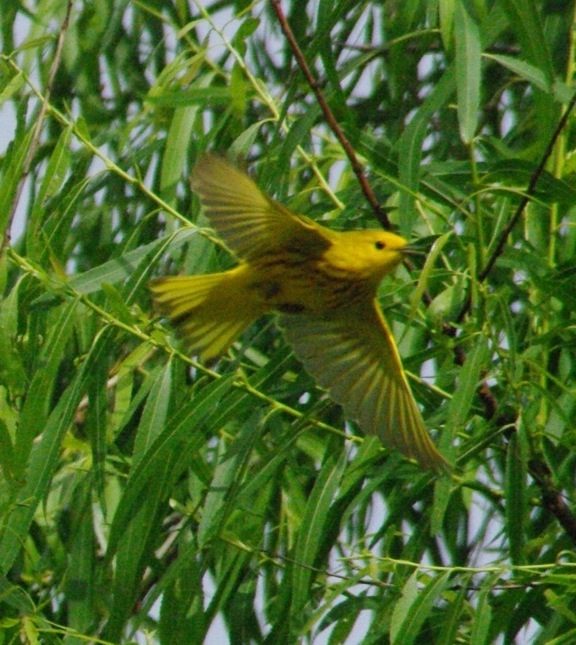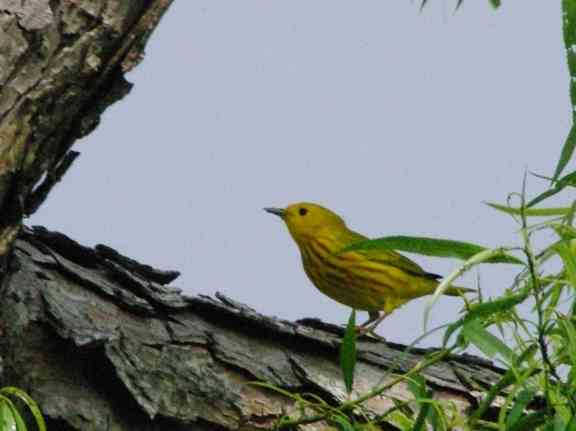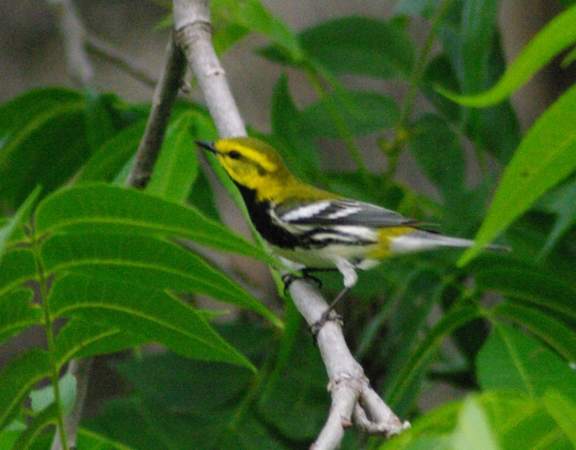There is a whole family of small, easily-overlooked woodland birds called Wood-Warblers (family Parulidae) that would probably never attract much attention except for the fact that, in spring plumage, the males are nothing short of magnificent in colorful patterns that rival the most beautiful of tropical birds. In spring, these small birds migrate north rapidly to their summer breeding grounds, eating constantly in the tops of large trees. They eat bugs, and lots of them. They eat millions of caterpillars that would otherwise denude the forests, and help keep the numbers of thousands of insect pests in balance with the amount of vegetation that the forest can easily supply. And because human activity has destroyed (and continues to destroy) so much of the once great eastern American forests, the also dwindling Wood-Warblers must migrate up a thin and disjunct chain of woodland running up the east coast, directly through the parks of New York City.
I remember seeing, in the treetops of New York City, Blue-winged Warblers, Nashville Warblers, Northern Parula Warblers, Chestnut-sided Warblers, Cape May Warblers, Magnolia Warblers, Black-and-white Warblers, Black-throated Blue Warblers, Cerulean Warblers, Blackburnian Warblers, Black-throated Green Warblers, Hooded Warblers, Bay-breasted Warblers, Yellow Warblers… sometimes as many as ten different species in the top of one tree at the same time, none of them over six inches long from beak to tail! It was so intense, that in the spring, all avid birdwatchers complained of a painful malady called “warbler neck.” This migration was one of those things that would be impossible to imagine – the color, the activity, the song, the sheer exuberance of tiny LIFE on the wing in the tops of giant trees, and it left so deep an impression that it has become a part of who I am.
Well, in Austin, the warbler migration is MUCH more subdued. I usually manage to see a Yellow Warbler or two each spring in our neighborhood parks. This spring was no exception:


We do have a Wood-Warbler that winters here, the Yellow-rumped Warbler, which is relatively common near water in the colder months. By this time of year, the Yellow-rumped Warbler has left for points north. Unfortunately, the Wood-Warbler migration in Austin doesn’t come close to the one in New York City.
But there is a wonderful exception to this – the Hill Country of Central Texas is the only breeding ground to a beautiful, rare and controversy-creating Wood-Warbler known as the Golden-cheeked Warbler. This bird in an endangered species, which means that the Federal Government has the legal authority to control land use to an extent to protect designated critical habitat, and this is where it gets controversial. Golden-cheeked warblers will only use the long curls of bark from a mature Ashe juniper (“cedar” to most of us) to build its nest, so limiting the cutting of mature “cedar” trees was one of the recommendations made to save the bird from extinction - this was, of course, very unpopular with many landowners. The Balcones Canyonlands National Wildlife Refuge in the City of Austin is one of the areas established specifically for the Golden-cheeked Warbler. Unfortunately, the conservation efforts taken so far to stem the tide of the Golden-cheeked Warbler’s demise have not yet been sufficient, as the warbler’s numbers are still declining. There are probably less than 21,000 birds now in existence.
Will the people of Central Texas modify their land-use policies enough to save the Golden-cheeked Warbler? Only time will tell.
For now, the Golden-cheeked warbler still hangs on in Central Texas. As a matter of fact, a beautiful male (and possibly some of his offspring) visited our neighborhood on Thursday, April 30th. Specifically, he visited the large pecan tree in my front yard, at about 6 PM. I watched (and photographed) him for about 45 minutes as he danced around the pecan canopy, snatching a bug here, gulping a caterpillar there, flashing his beautiful yellow, black, and white pattern for Austin to see. He reminded me, once again, that we have been given an incredibly beautiful world in which to live, but it is as fragile as it is precious. We need to act wisely so that we don’t destroy it.
For those who missed his visit, here are some photographs (click to enlarge):



